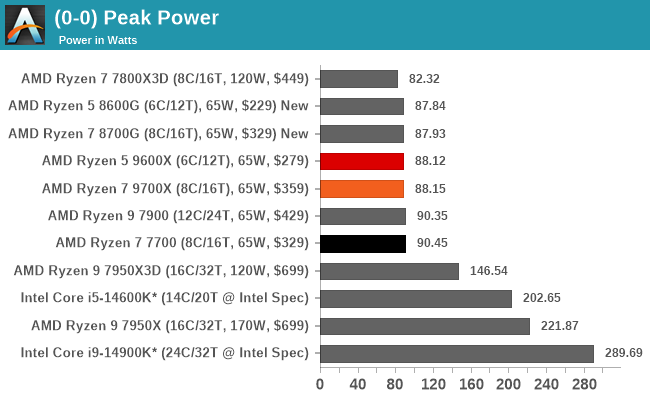The AMD Ryzen 7 9700X and Ryzen 5 9600X Review: Zen 5 is Alive
by Gavin Bonshor on August 7, 2024 9:00 AM ESTPower Consumption
Our previous sets of ‘office’ benchmarks have often been a mix of science and synthetics, so this time, we wanted to keep our office and productivity section purely based on real-world performance. We've also incorporated our power testing into this section.
The biggest update to our Office-focused tests for 2024 and beyond includes UL's Procyon software, the successor to PCMark. Procyon benchmarks office performance using Microsoft Office applications, with other web-based benchmarks such as Jetstream and timed runs of compilers, including Linux, PHP, and Node.js.
Below are the settings we have used for each platform:
- DDR5-5600B CL46 - Ryzen 9000
- DDR5-5600B CL46 - Intel 14th & 13th Gen
- DDR5-5200 CL44 - Ryzen 7000
Power
The nature of reporting processor power consumption has become, in part, a bit of a nightmare. Historically the peak power consumption of a processor, as purchased, is given by its Thermal Design Power (TDP, or PL1). For many markets, such as embedded processors, that value of TDP still signifies the peak power consumption. For the processors we test at AnandTech, either desktop, notebook, or enterprise, this is not always the case.
Modern high-performance processors implement a feature called Turbo. This allows, usually for a limited time, a processor to go beyond its rated frequency. Exactly how far the processor goes depends on a few factors, such as the Turbo Power Limit (PL2), whether the peak frequency is hard coded, the thermals, and the power delivery. Turbo can sometimes be very aggressive for TDP that are, broadly speaking, applied the same. The difference comes from turbo modes, turbo limits, turbo budgets, and how the processors manage that power balance. These topics are 10000-12000 word articles in their own right, and we’ve got a few articles worth reading on the topic.
- Why Intel Processors Draw More Power Than Expected: TDP and Turbo Explained
- Talking TDP, Turbo and Overclocking: An Interview with Intel Fellow Guy Therien
- Reaching for Turbo: Aligning Perception with AMD’s Frequency Metrics
- Intel’s TDP Shenanigans Hurts Everyone

Regarding peak power consumption, all of AMD's 65 W TDP designated chips fall between 87 and 88 W due to AMD's Package Power Tracking from the CPU socket itself (PPT), which boosts power for more performance. It is misleading regarding what the CPU is pulling power-wise compared to what the TDP states, but there are very few examples of any processor in the modern age following TDP.
Looking at how the AMD Ryzen 7 9700X compares to the previous Ryzen 7 7700, we can see both perform similarly regarding power consumption. Both chips, when loaded up with the Cinebench 2024 multi-threaded test, consistently tread between 88 W (9700X) and 90 W (7700). Power variation within the workload itself is very consistent, with very little differential as the workload progresses through the loop. Between the tests loading, we can see a consistent drop in power to just under 70 W briefly for the Ryzen 7 9700X and around 67 W for the Ryzen 7 7700. Given that both processors are nearly identical (8C/16T at 65 W TDP/88-90 W PPT), aside from the underlying core architecture, we can see striking similarities in power consumption and behavior under an intensive workload, too.











70 Comments
View All Comments
Golgatha777 - Wednesday, August 7, 2024 - link
Thanks for the review. I personally would have liked to see a 7800X3D in the benchmarks. Also, I would have omitted 720p and replaced it with 1440p gaming benchmarks. 1080p is perfectly fine for a synthetic benchmark to see which CPU is faster overall and a lot of gamers run 1440p.kpb321 - Wednesday, August 7, 2024 - link
Agreed. The 7800X3D should be very close in price to the 9700X so having both in the gaming charts would be pretty nice. Offhand I assume it will be a mix. For standard game the 9700x should have a small lead due to the Zen 5 improvements. For things that are cache sensitive that will make the 7800X3D more competitive or even faster.heffeque - Wednesday, August 7, 2024 - link
It doesn't make sense.The 7800X3D should be compared to the 9800X3D (which will come in a few months).
Trackster11230 - Wednesday, August 7, 2024 - link
It makes sense to compare the 7800X3D to the 9700X due to price, and I'm sure it'll be compared against the 9800X3D when it comes out too. These aren't mutually exclusive.Klober - Wednesday, August 7, 2024 - link
Seriously? Did none of you pay attention to the charts? There's clearly a 7800X3D in all but 2 of the charts on this page alone. I could maybe see an argument made for the 7900X3D (coincidentally, the CPU I have which I why I noted it's missing) but not the 7800X3D.Trackster11230 - Wednesday, August 7, 2024 - link
Yes, I see it in the charts, hence my comment about it making sense being in here. It's similar in price to the 9700X, so it makes sense to compare from that metric. What's so difficult to understand?I could make an argument too that an 8c/16t CPU makes more sense to compare to than the 7900X3D with 12c/24t.
boozed - Wednesday, August 7, 2024 - link
Seems odd that the gaming CPU is missing from the gaming resultsboozed - Thursday, August 8, 2024 - link
"Note: We are currently benchmarking more processors as we speak"I should read harder
Oxford Guy - Friday, August 16, 2024 - link
They said that they would re-test the Intel chips over the weekend in May. Did those updated benchmarks ever get done and published?frshi - Wednesday, August 7, 2024 - link
The table says Quad Channel DDR support, I don't think that's true. It's 4 slots but it's dual channel, isn't it?